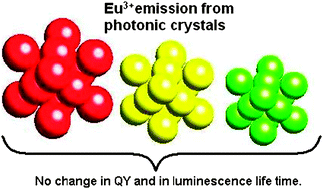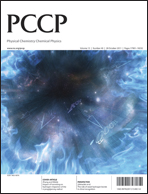Engineering spontaneous emission by means of photonic crystals (PHC) is under extensive study. However PHC modification of line emissions of rare earth (RE) ions has not been thoroughly understood, especially in cases of weak opal PHCs and while emitters are well dispersed into dielectric media. In this study, poly-methyl methacrylate (PMMA) opal PHCs containing uniformly dispersed europium chelate were fabricated with finely controlled photonic stop band (PSB) positions. Measurements of luminescent dynamics and angle resolved/integrated emission spectra as well as numerical calculations of total densities of states (DOS) were performed. We determined that in weak opals, the total spontaneous emission rate (SER) of Σ5D0–7FJ for Eu3+ was independent of PSB positions but was higher than that of the disordered powder sample, which was attributed to higher effective refractive indices in the PHC rather than PSB effect. Branch SER of 5D0–7F2 for Eu3+ in the PHCs, on the other hand, was spatially redistributed, suppressed or enhanced in directions of elevated or reduced optical modes, keeping the angle-integrated total unchanged. All the results are in agreement with total DOS approximation. Our paper addressed two unstudied issues regarding modified narrow line emission in weak opal PHCs: firstly whether PSB could change the SER of emitters and whether there exist, apart from PSB, other reasons to change SERs; secondly, while directional enhancement and suppression by PSB has been confirmed, whether the angle-integrated overall effect is enhancing or suppressing.

You have access to this article
 Please wait while we load your content...
Something went wrong. Try again?
Please wait while we load your content...
Something went wrong. Try again?


 Please wait while we load your content...
Please wait while we load your content...